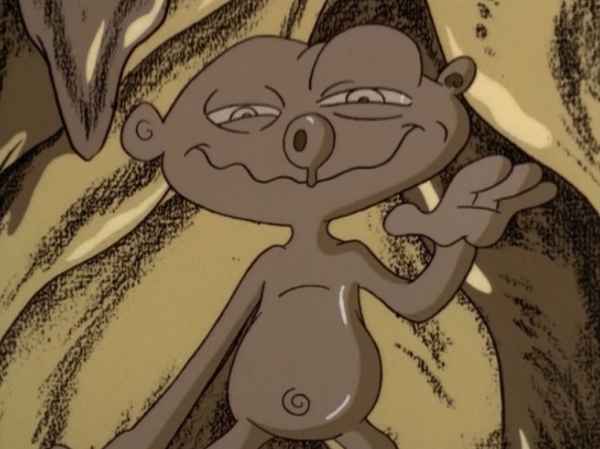Jumanji: The Animated Series
Written by Jonathan Wojcik, July 2013
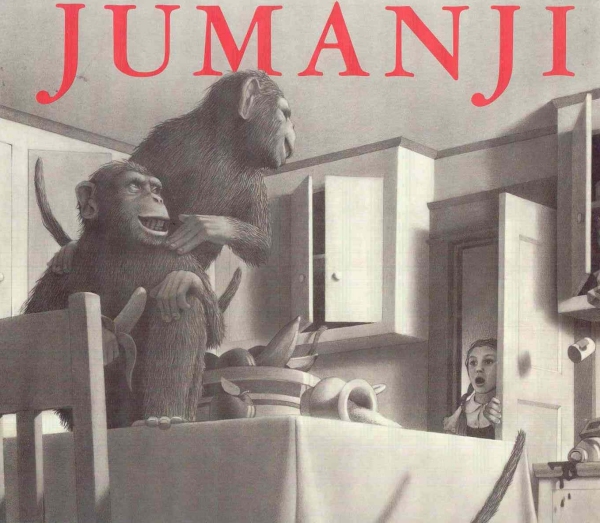
In 1981, Chris Van Allsburg published Jumanji, a short children's book in which a mysterious, jungle-themed board game magically unleashes wild animals and exotic dangers into reality. You know, like, monkeys come out of it. It's on the cover.
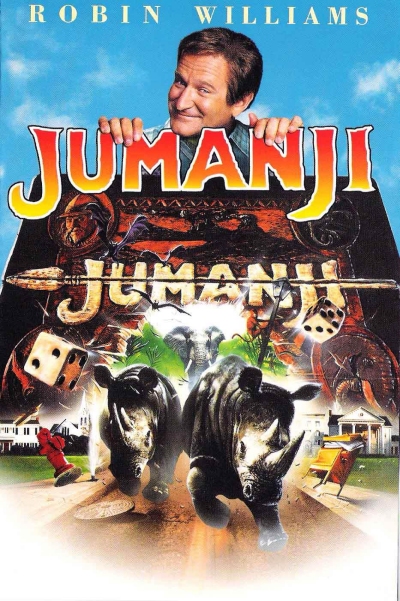
Over a decade later, director Joe Johnston took it upon himself to bring this weird little tale to the big screen, expanding the 32-page picture book into a 104 minute fantasy adventure featuring the scariest, hairiest jungle animal of them all, the Robin Williams. To pad out content for a feature length story, the supernatural game was now a much darker and more menacing force, capable of imprisoning losers until they are finally released by another game session. This is the fate which befalls a young boy, Alan Parrish, until he re-emerges from the game as a raving wildman.
Needless to say, putting Robin Williams in the same film as any number of monkeys resulted in the smash family hit of 1995, and like many smash family hits, somebody somewhere decided its success could be capitalized upon with a Saturday morning cartoon series. A series which, against all odds, would survive for forty episodes from 1996 to 1999.
So, why are we talking about Jumanji, of all things, on a site like spooky bugglyworms.com?
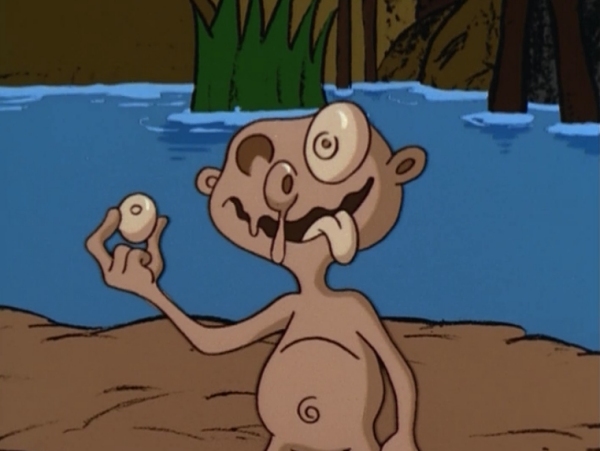
This is why.
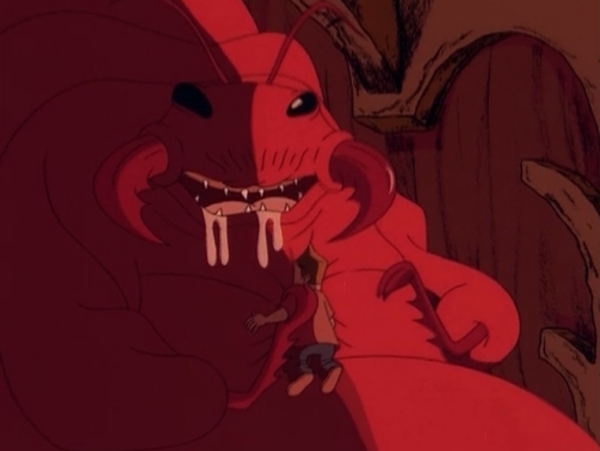
And whatever's happening here.
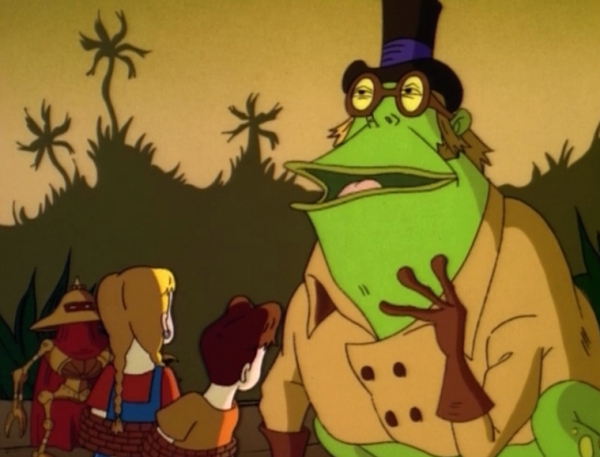
No, really, what's going on and why?!
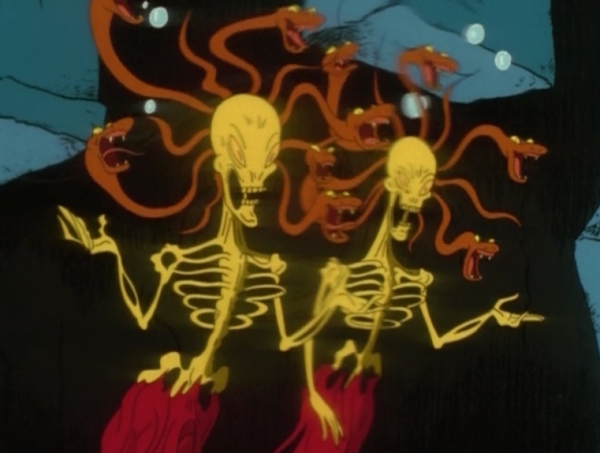
Jumanji: The Series was brought to life by the artwork of Everett Peck, whose cartoon credits include designing the vast majority of ghosts, demons and ectoplasmic oozers ever seen in The Real Ghostbusters, which is only the start of the bizarre course it chose to take. The simple story of a magical jungle-themed board game already needed some generous embellishment to support a single movie, and now it needed a mythos expansive enough to carry an entire series. Wisely, the series writers chose to focus on the question of where Alan Parrish actually went when the game imprisoned him, taking the opportunity to build an entire fantasy realm on the other side of the board.
A terrifying, terrifying fantasy realm.
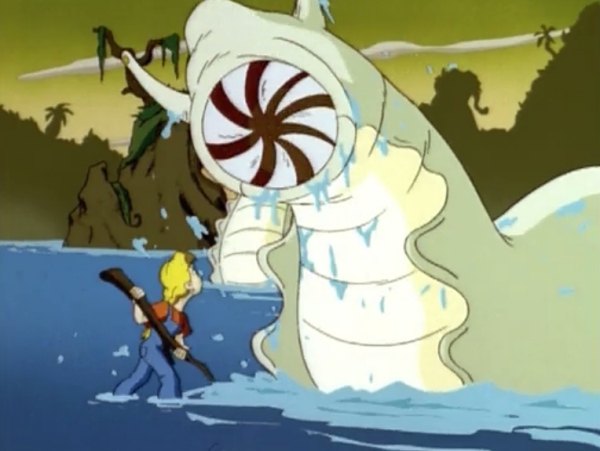
In the series, it's no longer normal for Jumanji to unleash wild animals and bad weather into the real world. Instead, every round transports its players to another world where they must solve the meaning of a riddle-like "clue" to be released. Alan, unfortunately, never read the rules of the game and never saw his personally tailored clue, indefinitely trapping him in the game's self-contained universe until he finally completes whatever quest the game originally intended for him.
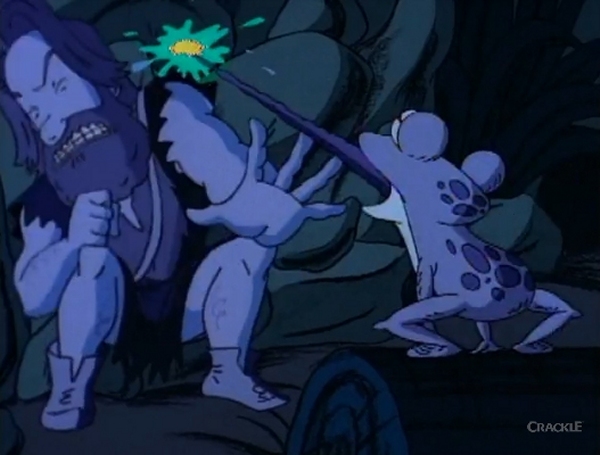
As you may have surmised from my screenshots, said universe is not just the African jungle implied by prior source materials. While it has its share of tigers, elephants, gorillas and crocodiles, it also positively swarms with colossal insects, ravenous predatory flora, prehistoric reptiles, demonic phantasms and twisted, nightmarish exaggerations of conventional animals. There are flesh-sucking anteaters, armadillos that can crush cars, tree frogs that can melt your face and a million other untold horrors waiting to mangle, envenomate or devour hapless intruders. If it exists in nature, Jumanji will turn it into a death machine. It's like Australia 2.0.

Equally dangerous cultures also lurk in Jumanji's jungles, including war-hungry ant people, the all-female "Jamazons" and most prominently the "Manjis," whose giant, eerie wooden masks are indistinguishable from their bodies. From episode to episode - sometimes even scene to scene - the Manjis are equally likely to be friends or foes, often deciding on a whim that their human friends might be better as a nice dinner. We eventually learn that it's possible for a human player to become a Manji through an elaborate ritual in which their own custom mask is produced from a cauldron. Putting on the mask seems to merge them with it completely, and over time, the process becomes irreversible. There's an implication that the Manji's may actually all be former players, particularly children, who lost themselves completely to the game world.

Even stranger than the wildlife may be the gradual reveal that much of Jumanji is artificial. The sky eventually ends at some sort of painted backdrop or dome. Huge clockwork mechanisms churn below ground. The sun is just a primitive looking satellite. Even many of those deadly, monstrous animals and plants turn out to have mechanical innards. It really is all one gigantic, immersive "game," and its logic follows suit. Physics work a little differently than they do in the real world, new areas and new enemies are unlocked according to the player's progress, and it even has its own set of non-player characters who simply respawn if they're ever killed.

One such character is the mad scientist, Professor Ipson, whose mild manners bely a misanthrope with a love of death and destruction. By the fifth episode, he's revealed to be the one who has conceived, built and continues to maintain many of Jumanji's hazards and creatures, but in a twist that will surprise nobody, he's subsequently revealed to be just another elaborate android, except for that time he was a giant frog for a while. Ipson never explains what Jumanji is or where it came from, but describes himself as "only a humble servant" of Jumanji, even speaking to it and addressing it as "master."
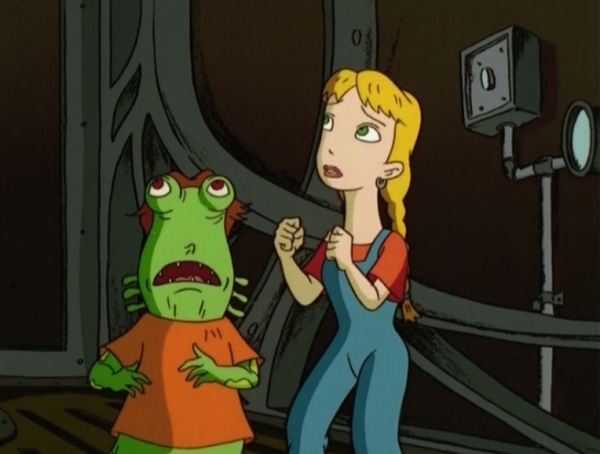
This is by no means the only time Jumanji is treated as a conscious entity, either. Alan describes it as a "sick" and "sadistic" thing that exists to amuse itself by toying with hapless children. It shows signs of awareness and emotion throughout the series, getting angry and vengeful when verbally insulted. It even seems to hold a special grudge against young Peter for his repeated attempts at cheating, transforming him into ridiculous animal hybrids as punishment. It still does this to Peter when someone else is the cheater, apparently out of some spiteful sense of humor.
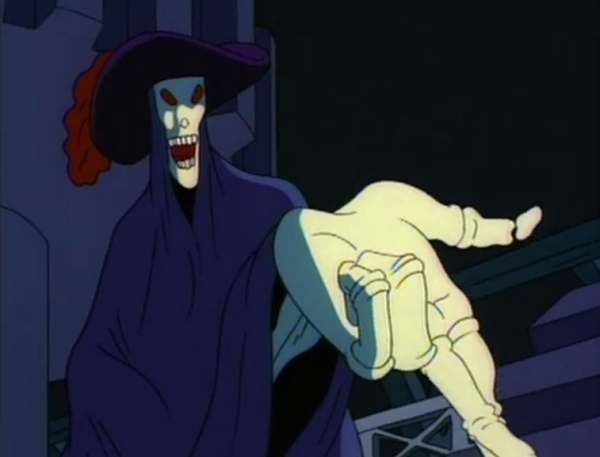
When the shit really hits the fan, an entity known only as The Stalker gets involved. We first see this skeletal phantasm in the episode "No Dice," when Alan brings Jumanji's dice inside its own world to stop the game from even being played. Emerging from a hellish-looking mine shaft, The Stalker relentlessly pursues Alan until the dice are returned.

The Stalker appears again in the episode "The Gift," when Alan is poisoned by a deadly centipede and his friends vow to destroy the game if they're unable to save him. Hearing this from his Victorian-era master control center, The Stalker decides that the best solution, rather than perhaps cure the venom and call it even, is to round up Jumanji's villains and just kill everybody. It's a shame we never see any more of The Stalker after his second appearance, and are never offered any further hints to his nature. Is he an avatar of Jumanji itself, or just its go-to henchman? The Darth Vader to its Palpatine?
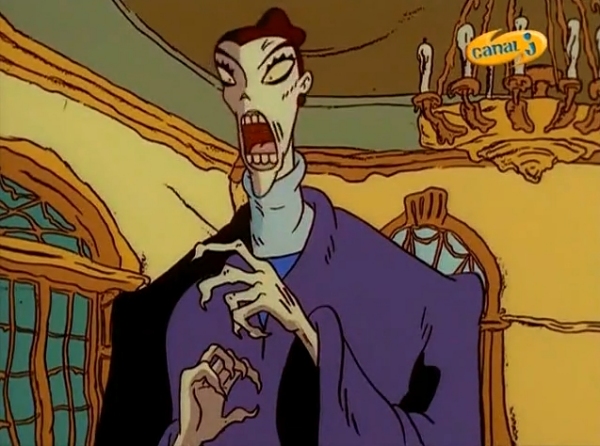
Mystery grows even thicker when we're given brief glimpses of other impossible "game" worlds; in one episode, the kids find a board game within Jumanji based on the real world, transporting them to a hideous and lethal distortion of their own neighborhood, complete with their dear old Aunt Nora. Judy must solve a mathematical problem to escape a Saw-like death trap and return everyone to the proper reality.

Another alternate death game is central to the episode "Ultimate Weapon," a small pyramid-shaped artifact called the transvector with striking similarities to the Puzzle Cube from Hellraiser.

When activated, the transvector opens a portal to an even deeper "nightmare realm" populated by even more hellish and surreal hazards, including a huge, white worm which later consumes and assimilates one of Ipson's vehicles. How far does this rabbit hole go? Just how many of these "games" are there? And WHY? Is Jumanji an even more expansive force than we thought, or are there many different, interconnected child-eating cybernetic demon games?

Unfortunately, the end of the series would leave us with far more questions than answers. Though they managed to get a designated "finale" episode, most of it is dominated by a clip show, rather hastily freeing Alan from the game in the final few moments before the kids finally vow to destroy it. They did have some friends in the game world...will that destroy them too? How is Alan going to integrate back into society? How many more games could be out there? We're left knowing no more about Jumanji's true nature or origins than when we began...but maybe a straight answer would just ruin all the fun.
Now that you're familiar with one of the most baffling settings in film-based-cartoon history, let's take a look at some of its weirder and more noteworthy inhabitants! In list format! Surprise! I tricked you into another list article! I'm a hack!
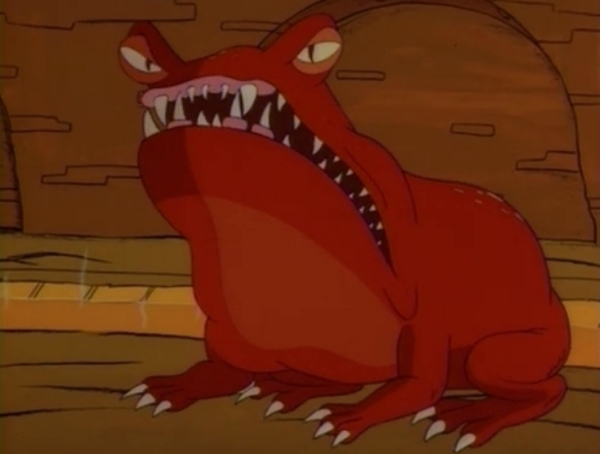
The Magma Toad
This bull-sized amphibian emerges from a river of molten rock in an underground mine shaft, its absurdly massive jaws more befitting of some deep-sea fish. I've seen a lot of lava-dwelling monsters based on aquatic life, from fish to cephalopods, but I've surprisingly rarely seen a volcanic Anuran. Maybe because if you're going to have a fire-loving amphibian, it's just a lot more likely you're going to go with "salamander."

The Caterpillar
They call it a caterpillar, but this monster has a lot more in common, anatomically, with a velvet worm, including a predatory diet, long antennae, identical soft legs down its whole body, and most notably, twin streams of "glue" it can fire from behind its head! Surprisingly, it's just a happy accident, since it was always considered a "caterpillar" in production art.
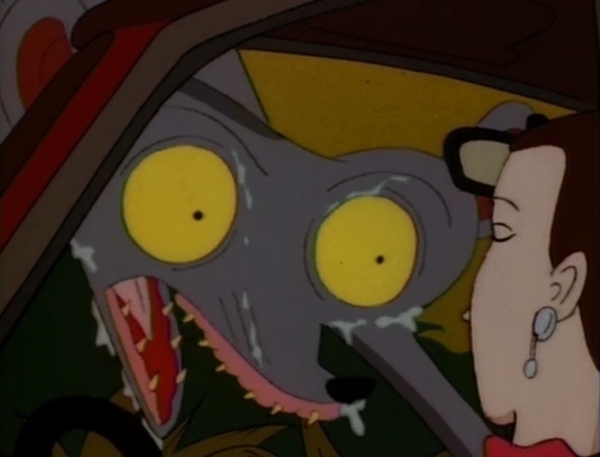
The Lemur-Shrew
I really don't know what else to call this thing. It's just a huge, grey, hairy shrew-like beast with the eyeballs of a gigantic bushbaby, grotesque gummy jaws full of tiny fangs and an incredibly weird cry between a grunt and a wheez. I really want one.
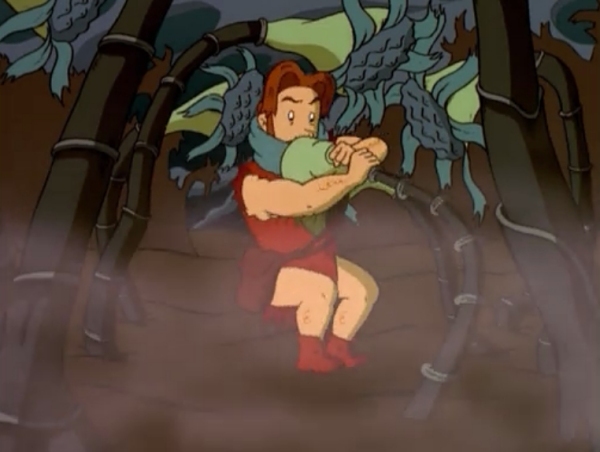
The Nightmare Plants
These aren't so much "cool" as "disturbing" in an uncomfortable sort of Deviantart way; encountered by Alan in the transvector's hell-realm, these mechanical lotuses apparently do nothing but forcibly inflate people, leaving Alan to drift away like a helpless balloon. Knowing what I know about internet fetish art, I'll leave the rest of that to your imagination.
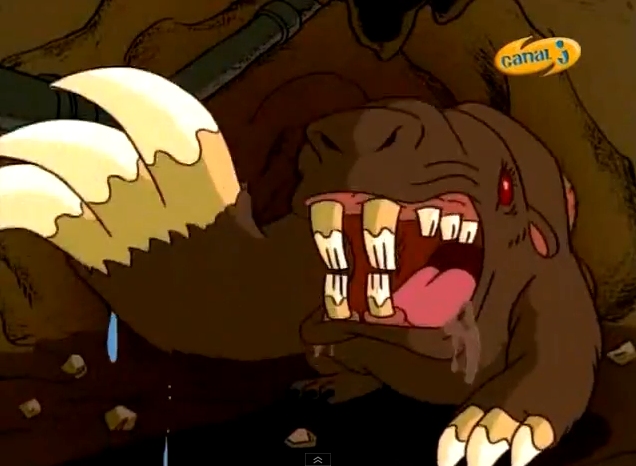
The Mole Rat
They call it a "mole," but again, our protagonists might just lack the extensive zoological knowledge to recognize an obvious mole rat, with tell-tale gnashing teeth. You might be asking why it's furry, but that's because the "naked" mole rat is merely the species that gets the most media attention. Not all of them are hairless!

The Nightmare Spiders
Besides the gigantic worm and the inflation plants, these are the only other creatures seen in the transvector's hell-dimension, hanging like fruit from thorny, twisted scrap-metal trees until unfurling into multi-legged mechanical eyeballs. They're able to spit thick, white, adhesive globs of what we can only hope is some sort of silk.
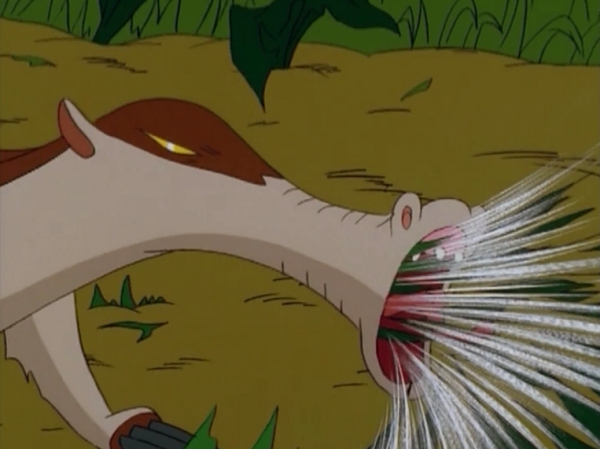
The Anteaters
Virtually everything in Jumanji has flesh-shredding fangs, even "anteaters," who make little sense to be called that when they apparently just eat literally everything they come across, vacuuming plants and animals alike into their tubular maws.

Mudboy
This weird little oozing golem is spontaneously brought to life from a scribble Peter draws in the mud, and seems to personify his most childish and selfish aspects. All Mudboy ever wants is to play, play, and play some more with his creator, hating rules or authority of any sort. So much so, he attempts to kill anyone who stands in the way of his fun. He also punctuates all of his important statements "mmmuck!"
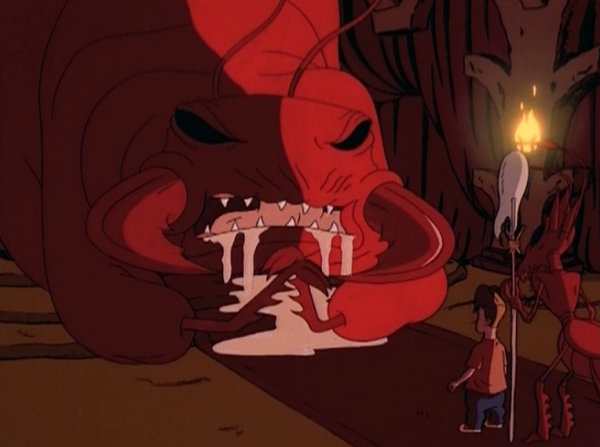
The Giant Ant People
Various species of giant ant are seen throughout the series, but only one is sapient, with the two opposing "black" and "red" colonies we've come to expect from cartoon Formicidae. They're lovable as characters, written with loads of personality and easy for our heroes to reason with and befriend, but their blind hatred for those dirty, dirty different-looking ants is unwavering. The anti-war, anti-prejudice messages here are never laid on thickly, but smoothly unfold as it becomes self-evident that neither side is "good" or "bad," and the sacred artifact they fight for is nothing but a ball of sticky dirt held together with saliva. A ball of sticky dirt that is equal parts black and red. A friendly red ant suffers one of the only permanent on-screen deaths of the series, and in the end, neither army learns a single lesson, which, honestly, works a lot better as an educational message. A lot of cartoons set kids up to think war and hate can disappear with one big epiphany. Here, we're shown that it's just not that easy.
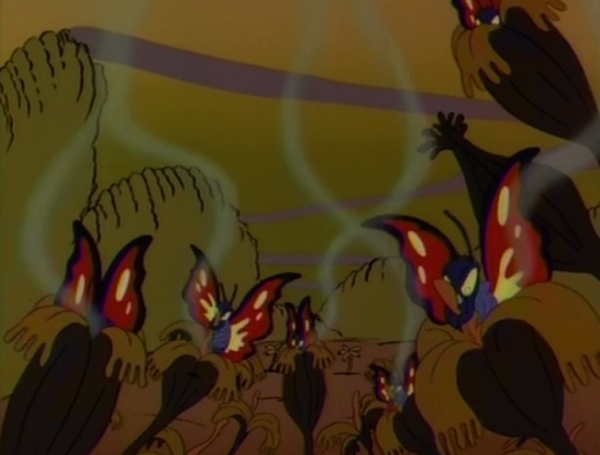
The Meat Flowers
I save these for last because they're easily the show's most clever "speculative biology" moment; when the kids are pursued by a swarm of deadly, flesh-eating butterflies, Alan leads them to a field of carnivorous flowers described as smelling "like rotten hamburger" - exactly how they lure their favorite prey! Whether they adapted just to feed on these butterflies isn't made entirely clear, though it does seem unlikely that Jumanji would contain only one vicious, swarming meat-loving insect.
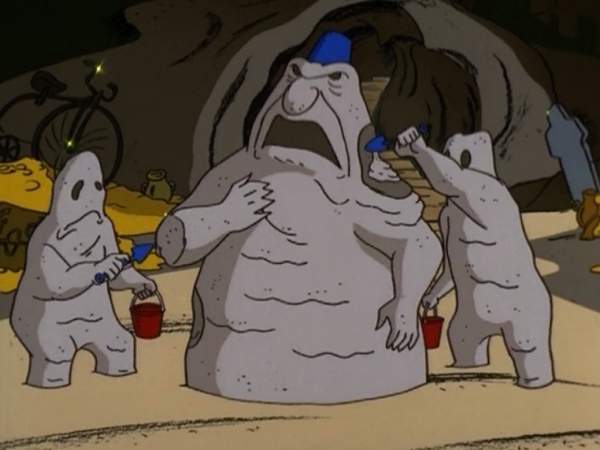
There are plenty more, of course, and a whole cast of additional villains we've barely delved into, but if you're really interested, you can easily find the entire series on Netflix or even youtube.

We started with a children's book about monkeys coming out of a board game. This spawned a movie about Robin Williams coming out of a board game, and this spawned a completely unique, weirdly drawn cartoon about a malevolent, sentient, child-eating bio-mechanical purgatory.
Thank you, Everett Peck. Thank you so much.
